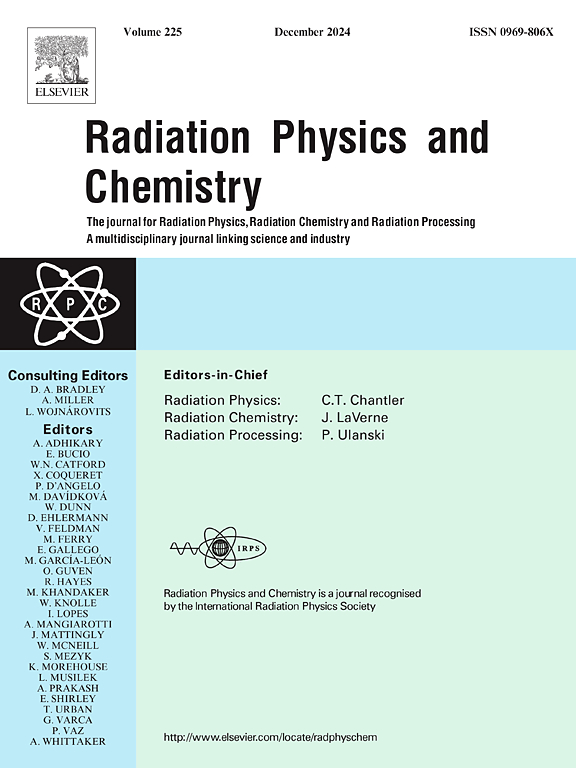Investigating the impact of Nb2O5 on structural and shielding properties of aluminum fluorosilicate glass systems
IF 2.8
3区 物理与天体物理
Q3 CHEMISTRY, PHYSICAL
引用次数: 0
Abstract
This study investigates the structural, optical, and gamma-ray shielding properties of aluminum fluorosilicate glasses with the composition 45SiO2–15Al2O3–10CaF2–15Na2O–5NaF-(10-x)SrO-xNb2O5 (x = 0, 5, 10 mol%). Glasses were synthesized using the melt-quenching technique and characterized via XRD, FTIR, and gamma-ray attenuation measurements. XRD confirmed the amorphous nature of all samples, with Nb2O5 incorporation causing a shift in the broad halo position, indicating network depolymerization. FTIR analysis revealed structural modifications in Si–O–Si and Si–O–Al linkages. The introduction of Nb2O5 significantly enhanced gamma-ray shielding properties, with increased mass and linear attenuation coefficients, particularly at lower energies. The effective atomic number (Zeff) and equivalent atomic number (Zeq) showed a positive correlation with Nb2O5 content, while the energy absorption buildup factor (EABF) exhibited composition-dependent variations. These findings demonstrate that Nb2O5 substitution improves radiation shielding capabilities while maintaining structural stability. The study provides a foundation for developing advanced, lightweight, and transparent radiation shielding materials, offering a viable alternative to traditional heavy-metal-based shields for use in medical, nuclear, and industrial applications.
研究Nb2O5对氟硅酸铝玻璃体系结构和屏蔽性能的影响
本研究研究了45SiO2-15Al2O3-10CaF2-15Na2O-5NaF -(10-x)SrO-xNb2O5 (x = 0,5,10 mol%)氟硅酸铝玻璃的结构、光学和伽马射线屏蔽性能。采用熔融淬火技术合成了玻璃,并通过XRD, FTIR和伽马射线衰减测量对其进行了表征。XRD证实了所有样品的无定形性质,Nb2O5的加入导致宽晕位置的移动,表明网络解聚。FTIR分析显示Si-O-Si和Si-O-Al键的结构改变。Nb2O5的引入显著增强了伽马射线屏蔽性能,增加了质量和线性衰减系数,特别是在较低能量下。Nb2O5的有效原子序数(Zeff)和等效原子序数(Zeq)与Nb2O5的含量呈正相关,而能量吸收积累因子(EABF)则呈现组分依赖性变化。这些发现表明,Nb2O5取代提高了辐射屏蔽能力,同时保持了结构的稳定性。该研究为开发先进、轻量化和透明的辐射屏蔽材料提供了基础,为医疗、核和工业应用中使用的传统重金属屏蔽提供了可行的替代方案。
本文章由计算机程序翻译,如有差异,请以英文原文为准。
求助全文
约1分钟内获得全文
求助全文
来源期刊

Radiation Physics and Chemistry
化学-核科学技术
CiteScore
5.60
自引率
17.20%
发文量
574
审稿时长
12 weeks
期刊介绍:
Radiation Physics and Chemistry is a multidisciplinary journal that provides a medium for publication of substantial and original papers, reviews, and short communications which focus on research and developments involving ionizing radiation in radiation physics, radiation chemistry and radiation processing.
The journal aims to publish papers with significance to an international audience, containing substantial novelty and scientific impact. The Editors reserve the rights to reject, with or without external review, papers that do not meet these criteria. This could include papers that are very similar to previous publications, only with changed target substrates, employed materials, analyzed sites and experimental methods, report results without presenting new insights and/or hypothesis testing, or do not focus on the radiation effects.
 求助内容:
求助内容: 应助结果提醒方式:
应助结果提醒方式:


